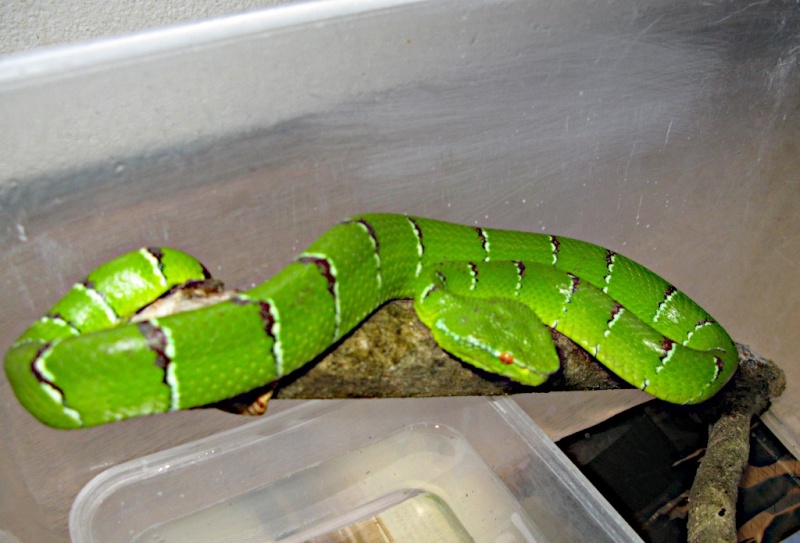Tropidolaemus subannulatus (Gray, 1842)
Mindanao Temple Viper
Trimesurus subannulatus Gray, 1842: 48. —Type locality. “The Philippines”. - Syntypes. BMNH 1946.1.19.32-33 (female and young). Coll. by H. Cuming. The Syntypes show clearly the species from Mindanao.
Comments.
Trimesurus subannulatus Gray, 1842 was synonymised with
Trimeresurus wagleri by GÜNTHER (1864). It is however the oldest available name for populations of the Philippines and conspecific populations. No subspecies are recognized at the moment.
Status. A valid name; recognized here as
Tropidolaemus subannulatus, the valid specific name of Philippine populations (at the exception of Negros, Palawan, Luzon and excluding those referred to
Tropidolaemus philippensis) and populations of Borneo, Sulawesi and adjacent islands (excepted the form referred to
Tropidolaemus laticinctus Kuch, Gumprecht & Melaun, 2007) if these latter ones proved to be conspecific with Philippine populations. The specific taxon
subannulatus is the oldest available name for the oriental clade of the
Tropidolaemus wagleri complex.
Diagnosis.—A species of the genus
Tropidolaemus, characterized by the internasals separated by 2 (rarely 1) scales, never in contact; a background colour in the shades of green, namely green, blue or green and blue ground in females, green in males and juveniles; crossbands around the body blue and white, red and white, blue, blue and red or white in adult females, white parts can be light blue in life, white spots or white and red spots in males and juveniles; a variable postocular stripe in adult females and a white and red one in juveniles and males; in adult females the belly is uniform or blotched with blue or red, never banded, in males and juveniles the belly is uniform or with red dots; 128–148 VEN in males and 127–147 in females, SC: 45–53 in males and 40–54 in females; 21–23 MSR in males and 21–29 in females, keeling variable in both sexes; 4–7 scales on the snout at males and 5 – 8 in females; 3rd SL nearly always (87 / 90 occurrences) separated from the subocular by 1 scale or 2 scales, without sexual dimorphism; tail long in males, with a ratio TaL/TL between 0.146 and 0.182, moderate to long in females, 0.139–0.183; occipital scales distinctly keeled in males.
Distribution
Island of Mindanao, known from around Davao, General Santos City in the South and around Surigao City in the North. We believe, the species is common and widly found all over Mindanao. The Species describet here is endemic to Mindanao and possibly smaller islands around.
Habitat
The Mindanao habitat is known from Surigao and is comperable with habitats of other
Tropidolaemus forms from elswhere. In Mindanao it is found at elevations ranging from sea-level up to about 1200 m, but most frequent in the well-watered lowlands. It inhabits loweland rainforests, tropical wet montane forests, closed or open swamps and marshes, mangoves and coastal swamps, where it lives abouve water, and in bushes close to rice paddies and ditches in villages.
Body characteristics
Size: Large and stoud species. Maximum length about 130 cm and and average length ot 80 cm in females, males being much smaller and thinner.
Head: Triangular, very distinct from the body. Scales on the head, as well as the gular scales, small and strongly keeled (the population in North Mindanao seems to have more smouth scales). Eye small with a vertical slit-shaped pupil. Pupil orange-red. Eight to ten supralabials, non bordering the eye. Nine to twelve sublabials, several loreal shields and small temporal scales. The second supralabial does not border the anterior margin of the loreal pit and is bordered above by a pre-foveal shield. Two long, hinged fangs in the upper jaw. In a closed mouth the fangs are folded back, but they turn into position when the animal bites.
Body and Colour: see above (Diagnosis)
Identification
Ist easy to recognise this species on a combination of the distinctly triangular form of the head, the stout body, the vertical slit-shaped pupil and the small, strongly keeled top and head gular scales.
Tropidolaemus subannulatus differs from the snake of the generus Trimeresurus in Mindanao in that latter has a less distinct triangular and unkeeled gular scales.
Biology
The Mindanao Temple Adder is a slugish animal and the autor found several snakes over a time-periode of several weeks on the same tree trunk. This snakes is found shaddowed, moist places, and apppreciates places such as bathrooms (DAVID & VOGEL, 1996).
Tropidolaemus subannulatus is a crepuscular and nocturnal species that retreats during the day in hollow tree trunks or in tangled vegetation. This snake feeds mainly on frogs, but also may take occasionally small lizards and mammals. Juveniles prey upon frogs and lizards. While striking, the eyes and the loreal pits are partially covered by scales. This is the possible through the existence of a lachrymal groove underneath the eye (BOYER & ROBERTS, 1998). It allows the scales to move forward and upward. So these important organs are protected, while the snake holds prey after a predatory strike. Tropidolaemus subannulatus is ovoviviparous, giving birth to about fifteen young, with a maximum record of fourthy-one juveniles in captivity (LIM, 1990). All are born in a yolk sack, about 12 cm long and pencil thick. Own datas shows, young snakes displays cannibalism. It is a docile snake during the daytime, seldom striking or attempting to bite unless roughly handled.

young
T. subannulatus female

young
T. subannulatus male
Cheers
Mario






